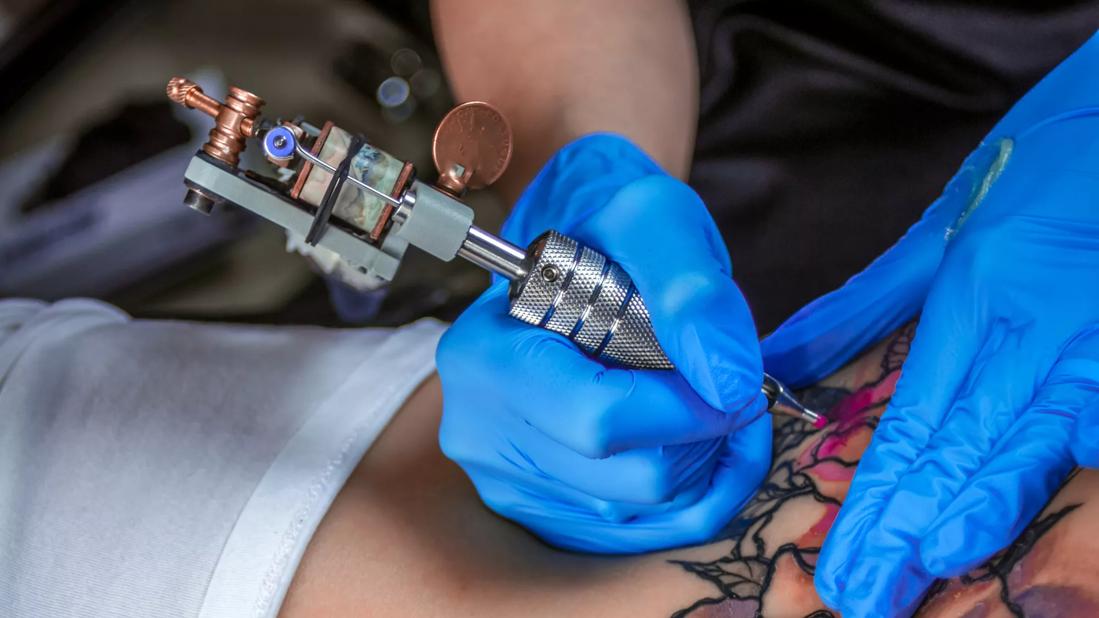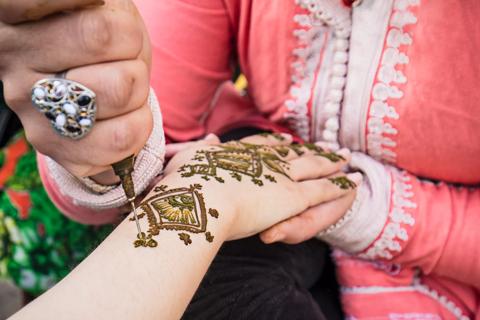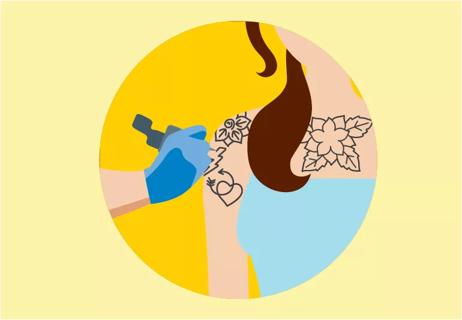Help your ink heal by keeping it moisturized and protected from the sun

Thinking about new ink? Maybe your mom’s name boldly displayed across your arm or a small flower discretely located on your ankle?
Advertisement
Cleveland Clinic is a non-profit academic medical center. Advertising on our site helps support our mission. We do not endorse non-Cleveland Clinic products or services. Policy
Tattoos are getting more popular all the time. According to the Pew Research Center, 32% of adults in the U.S. have at least one tattoo, with 22% having more than one.
And the majority of those branding sessions go off without a hitch.
“In most cases, tattoos aren’t harmful,” says dermatologist Alok Vij, MD. “But there are some risks you should know about if you’re considering a tattoo.”
Modern tattoo artists perform their magic with machines that use multiple needles to inject colored pigments into the dermis, the middle layer of skin. Unsurprisingly, that doesn’t feel great.
“Getting a tattoo can be painful,” Dr. Vij says. “And while the pain is temporary, the artwork is forever.”
So, are you ready for some ink? If so, you should also be ready for your tattoo aftercare.
Dr. Vij helps us prep by giving us some advice and instructions on new tattoo aftercare and when you should be concerned about an infection.
You can expect your new tat to hurt a bit the day you get it, but it should feel better over the next few days. Here’s how to help the healing process along.
When it comes to what to use for tattoo aftercare, you’ll need the following items:
Advertisement
“Tattoos are controlled forms of trauma to your skin, which needs support to heal properly” says Dr. Vij. “Improper or negligent aftercare can compromise the healing process, leaving you with infections, rashes, scars or smudges in your tattoo, and you’ll only have yourself to blame.”
It can take a few months for your tattoo to fully heal — it all depends on the size of the tattoo and where it’s located. If your tattoo is on the larger side, you may notice redness and swelling for longer.
How should you take care of your new tattoo? Dr. Vij provides this tattoo aftercare timeline with the steps you should follow to ensure your new ink heals well.
After you receive your tattoo, your tattoo artist should apply a thin layer of ointment to the area and cover your tattoo with a bandage. Your tattoo artist should also send you home with instructions for caring for your body art. You’ll typically need to keep it covered for at least 24 hours.
When you’re ready to remove the bandage, you want to be delicate. (And wash your hands first!)
“Soak the bandage in warm water to soften it before gently peeling it off,” Dr. Vij instructs. “Then, wash it with a gentle cleanser and warm water. Avoid scrubbing or rubbing the area.”
Opt for a soap that’s mild and doesn’t contain any harsh ingredients, perfumes or dyes. Once you’re done cleaning, gently pat the area dry with a soft washcloth or towel.
After this point, you don’t have to cover the area with a new bandage or dressing. You may notice that the tattooed area oozes a little — this is a mix of blood and ink. Your skin may also feel sore and may appear red. While alarming, these are all normal signs that your body is starting to heal.
Also, if you need to wear clothing over the area, opt for loose, breathable options. You want to keep the area exposed so it can breathe.
During the first two weeks, you may start to feel some itching and notice flaking in and around the tattoo. This is normal. You may also notice scabs forming.
Do your best to not scratch or pick at any scabs.
Dr. Vij says that you should continue to wash the area twice daily with a gentle cleanser — and apply a moisturizer to the area to prevent any scabbing and help ease any itching.
So, what kind of lotion should you use? Look for a mild, gentle moisturizer or ointment. Your tattoo artist may have a brand that they recommend you use, but overall, look for one that’s fragrance-free and dye-free to avoid irritating your skin.
Advertisement
After about three weeks, you’ll notice the scabs healing and a reduction in flakiness. Keep cleaning and moisturizing the area daily.
Once you reach the two-month mark, the top layer of your skin typically has healed, leaving your tattoo looking bright and vibrant.
But know that it can take the bottom layers of your skin several months to completely heal and that your overall healing time can vary.
While you don’t need to cleanse the area daily anymore, you can keep applying moisturizer as needed.
There’s also a handful of don’ts when it comes to tattoo care. Dr. Vij suggests you avoid the following:
“You want to strike that delicate balance between keeping the skin clean and moisturized so it can heal; neither too moist so the skin ‘prunes’ or gets macerated, nor too dry so the tattoo crusts or scabs over,” shares Dr. Vij. “Petroleum jelly can block the pores in your skin, potentially leading to an overgrowth of bacteria and increased inflammation in the healing process. Instead, look for a noncomedogenic product.”
Advertisement
“One of the biggest risks is tattoo regret,” notes Dr. Vij. (Sure, there’s laser tattoo removal, but it’s painful, expensive and can take months). That’s why it’s good to stop and think a minute before you get your new crush’s name etched into your skin.
Besides pain and potential regret, there are some possible health risks from tattoos, Dr. Vij says:
While some redness, flaking and scabbing are normal as your tattoo heals, Dr. Vij says you should see a doctor if you notice any signs of infection. This includes:
Advertisement
But the majority of tattoos heal fine without lasting problems. “These complications are rare, but it’s good to be aware of the possibility,” Dr. Vij states.
Once your tattoo has fully healed, you’ll need to think about maintenance. Some inks can fade in response to UV (ultraviolet) light. Sun damage can also weaken the collagen fibers in the dermis, where the pigment is housed.
To keep your new artwork looking bright and crisp, coat your tattoo with sunscreen when you’re out in the sunshine. (But you were wearing sunscreen anyway, right?)
With the right TLC and by following the recommended tattoo aftercare, your new body art will soon be healed and just another beautiful part of the skin you’re in.
“Ink is forever,” Dr. Vij says. “But the outcome of your tattoo depends on the quality of your aftercare almost as much as it depends on the skill of your tattoo artist.”
Learn more about our editorial process.
Advertisement

Ink may cause serious skin reactions to tattoos

The dangers of self-tattoo kits. Yes, we’re wincing

Early attention to skin wounds can help minimize their appearance later

Several conditions, like vitiligo and fungal infection, can cause a loss of pigmentation, leading to white spots or patches on your skin

Moisturizing, running a humidifier and adjusting your showers may help keep itchiness and irritation at bay

‘Zit stickers’ can help heal a new or popped pimple, but they’re limited when it comes to managing acne

Glycolic acid benefits skin tone, texture and pigmentation by exfoliating dead skin

At-home treatments and lifestyle changes may help ease the symptoms and improve the appearance of varicose veins — but they aren’t a cure

The best parenting style balances enforcing rules and showing plenty of love

Tips include cutting back on sugar, focusing on exercise and managing stress

It can be harder to let go when you’ve invested time, energy and emotions — but it might be the healthier choice long term